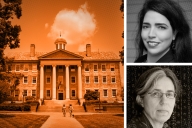You have /5 articles left.
Sign up for a free account or log in.
When Mount Holyoke College administrators announced in March that they would be freezing tuition and fees for the 2012-13 school year, the college’s president, Lynn Pasquerella, said the announcement was the start of a long-term shift on how the college approached issues of affordability.
Pasquerella stuck by her word Thursday, announcing that the price of tuition would hold constant -- at $41,270 -- for at least another year. The price of room and board will also be held constant.
“We’re committed to our mission of providing a quality education to students regardless of socioeconomic background,” Pasquerella said in an interview. “We can’t continue to raise tuition, with burgeoning student loan burdens, and increase the discount rate for the college. We were motivated to have long-term financial sustainability while simultaneously providing access.”
While tuition freezes are common in higher education, many say such moves tend to be gimmicks designed to attract attention, rather than real reforms. It is rare for institutions to stick with them for multiple years. Holyoke’s decision to remain at the same price for at least three consecutive years makes it an outlier, and the college could soon become seen as one of several high-profile experiments -- along the lines of the University of the South's 2011 decision to cut its sticker price by 10 percent -- of colleges taking substantive steps to reform the price of attending college.
Previous tuition-freeze attempts by other colleges in Mount Holyoke's stratum of wealth and selectivity, such as Williams College and Princeton University, were abandoned shortly after, and those colleges now have prices as high, if not higher, than those of their peers.
While rising college prices are still a big public concern, particularly when it comes to public universities, the actions of Holyoke and other private, nonprofit colleges and universities in recent years show that the concern is starting to have a noticeable effect on pricing strategies.
In its annual “Trends in College Pricing” report, the College Board reported that the average increase in published tuition prices at private, not-for-profit colleges and universities has decreased each decade since 1982. For the past 10 years, the price of tuition, room, board and fees at private institutions, while on average significantly higher than at public universities, has increased an average of only 2.4 percent a year, adjusted for inflation, compared to an average 3.8 percent increase for public four-year institutions.
That same study found that the inflation-adjusted price of attending a private college in 2012, including financial aid, was only 2.3 percent higher than it was in 2007.
A survey released earlier this year by the National Association of Independent Colleges and Universities, which represents 960 private institutions, found that the sticker-price increase at private universities for the current year was the lowest in four decades, at only 3.9 percent. The association keeps a list of measures its members have taken to control costs.
Pasquerella, who speaks nationally about the need to control college costs and the unsustainable trajectory of prices over the past few decades, said the goal of the freeze is to introduce more transparency into the price of college to help attract a broader array of students. “A lot of families don’t understand that it’s often less expensive to attend a private college because of our capacity to meet full need,” she said.
Pasquerella expressed some reservation about how long the college would be able to hold down tuition prices. The college is also looking for efficiencies to control the cost of delivering a college education, particularly in partnerships with the rest of the Five College Consortium.
For now, though, the freeze appears to be good for the college. Mount Holyoke actually brought in more in tuition revenue this year than last year, Pasquerella said, because the tuition freeze let the college hold down how much it was giving out in aid. About 70 percent of the college’s students receive need-based financial aid.








